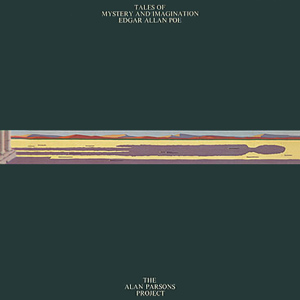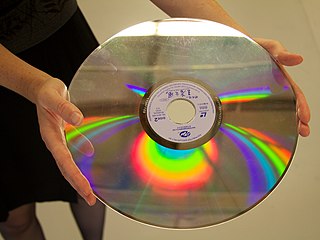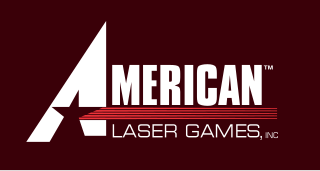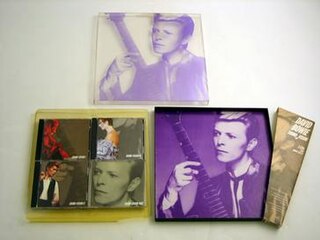
Video CD is a home video format and the first format for distributing films on standard 120 mm (4.7 in) optical discs. The format was widely adopted in Southeast Asia, South Asia, Greater China, Central Asia and West Asia, superseding the VHS and Betamax systems in the regions until DVD-Video finally became affordable in the first decade of the 21st century.

Tales of Mystery and Imagination (Edgar Allan Poe) is the debut studio album by British rock band The Alan Parsons Project. It was released on 25 June 1976 in the United Kingdom by Charisma Records. The lyrical and musical themes of the album, which are retellings of horror stories and poetry by Edgar Allan Poe, attracted a cult audience. The title of the album is taken from the title of a collection of Poe's macabre stories of the same name.

The LaserDisc (LD) is a home video format and the first commercial optical disc storage medium, initially licensed, sold and marketed as MCA DiscoVision in the United States in 1978. Its diameter typically spans 30 cm (12 in). Unlike most optical-disc standards, LaserDisc is not fully digital, and instead requires the use of analog video signals.
Full-motion video (FMV) is a video game narration technique that relies upon pre-recorded video files to display action in the game. While many games feature FMVs as a way to present information during cutscenes, games that are primarily presented through FMVs are referred to as full-motion video games or interactive movies.

The BBC Domesday Project was a partnership between Acorn Computers, Philips, Logica, and the BBC to mark the 900th anniversary of the original Domesday Book, an 11th-century census of England. It has been cited as an example of digital obsolescence on account of the physical medium used for data storage.

NBCUniversal Entertainment Japan LLC is a Japanese music, anime, and home entertainment production and distribution enterprise that is a subsidiary of NBCUniversal headquartered in Akasaka, Minato, Tokyo. It is primarily involved in the production and distribution of anime within Japan.

The Criterion Collection, Inc. is an American home-video distribution company that focuses on licensing, restoring and distributing "important classic and contemporary films". Criterion serves film and media scholars, cinephiles and public and academic libraries. Criterion has helped to standardize certain aspects of home-video releases such as film restoration, the letterboxing format for widescreen films and the inclusion of bonus features such as scholarly essays and documentary content about the films and filmmakers. Criterion most notably pioneered the use of commentary tracks. Criterion has produced and distributed more than 1,000 special editions of its films in VHS, Betamax, LaserDisc, DVD, Blu-ray and Ultra HD Blu-ray formats and box sets. These films and their special features are also available via The Criterion Channel, an online streaming service that the company operates.

In optical storage, constant angular velocity (CAV) is a qualifier for the rated speed of any disc containing information, and may also be applied to the writing speed of recordable discs. A drive or disc operating in CAV mode maintains a constant angular velocity, contrasted with a constant linear velocity (CLV).

American Laser Games was a company based in Albuquerque, New Mexico that created numerous light gun laserdisc video games featuring live action full motion video. The company was founded in the late 1980s by Robert Grebe, who had originally created a system to train police officers under the company name ICAT and later adapted the technology for arcade games. Its first hit game was Mad Dog McCree, a light gun shooter set in the American Old West. By mid-1995 they were recognized as the leading company in the medium of laserdisc-based arcade games. Almost all arcade games released by the company were light gun shooters and a number of them also had an Old West theme.
An interactive film is a video game or other interactive media that has characteristics of a cinematic film. In the video game industry, the term refers to a movie game, a video game that presents its gameplay in a cinematic, scripted manner, often through the use of full-motion video of either animated or live-action footage.

Rick Prelinger is an American archivist, writer, and filmmaker. A professor at the University of California, Santa Cruz, Prelinger is best known as the founder of the Prelinger Archives, a collection of 60,000 advertising, educational, industrial, and amateur films acquired by the Library of Congress in 2002 after 20 years' operation.

Sound + Vision is the first box set by English musician David Bowie, released by Rykodisc in 1989. By the end of the 1980s, the rights to Bowie's pre-1983 catalogue reverted to Bowie and his former management company, MainMan. Rykodisc had approached Bowie in 1988 to re-release his albums on CD and Bowie agreed, and in September 1989 the Sound + Vision box set was released. By April 1990, the box set had sold over 200,000 copies, which, for a set costing $50–$60, was considered "phenomenal".

Blond Ambition World Tour Live is a video album by American singer-songwriter Madonna released exclusively on LaserDisc by Pioneer Artists on December 13, 1990. It contained the Blond Ambition World Tour's final show, filmed at the Stade Charles-Ehrmann in Nice, France, on August 5, 1990. The concert had previously been broadcast on American network HBO as Live! Madonna: Blond Ambition World Tour 90, and became one of its highest rated specials. The decision to release it exclusively on Laserdisc grew when Pioneer Artists signed up to sponsor the tour; the company also wanted to use Madonna to reach a new demographic and increase Laserdisc sales. It received positive reviews, with some critics saying it captured the concert better than the documentary Madonna: Truth or Dare (1991) and the HBO broadcast. At the 34th Annual Grammy Awards, it won for Best Music Video-Long Form, becoming the first Grammy award Madonna received in her career. With over 100,000 copies sold, Blond Ambition World Tour Live was one of the highest selling laserdiscs of its time.

A CD-ROM is a type of read-only memory consisting of a pre-pressed optical compact disc that contains data. Computers can read—but not write or erase—CD-ROMs. Some CDs, called enhanced CDs, hold both computer data and audio with the latter capable of being played on a CD player, while data is only usable on a computer.
Sony Digital Audio Disc Corporation is a manufacturer of CDs, DVDs, UMDs, and Blu-ray Discs. The company has many plants worldwide. Although it primarily services Sony Music Entertainment-owned record labels, Sony Pictures Home Entertainment, and Sony Interactive Entertainment, it also manufactures discs for other labels, home entertainment distributors, and video game publishers.

This is a comprehensive list of all of the commercially released recordings made by Orson Welles. Welles is heard on many recordings that were not intended for commercial release and for which he was not compensated.
While every attempt has been made to provide a complete listing of Welles's commercial recordings in the order of their release, it would be folly to assume that such a list could ever be compiled with certainty.

LV-ROM is an optical disc format developed by Philips Electronics to integrate analog video and computer software for interactive multimedia. The LV-ROM is a specialized variation of the CAV Laserdisc. LV-ROM is an initialism for "LaserVision Read-Only Memory".

The Citizen Kane trailer is a four-minute, self-contained, "making of" promotional short film by Orson Welles and the Mercury Theatre, released in 1940 to promote the film Citizen Kane. Unlike other standard theatrical trailers of the era, it did not feature any footage of the actual film itself, but was a wholly original pseudo-documentary piece. It is considered by numerous film scholars such as Simon Callow, Joseph McBride and Jonathan Rosenbaum to be a standalone short film, rather than a conventional "trailer", and to represent an important stage in developing Welles's directorial style.

The Inland Sea is a 1991 American travel documentary directed by Lucille Carra. It is inspired by the 1971 travelogue of the same title written by Donald Richie. In the documentary, filmmaker Carra undertakes a similar trip across the islands of Japan's Inland Sea as Richie did twenty years prior. Donald Richie narrates the film.














